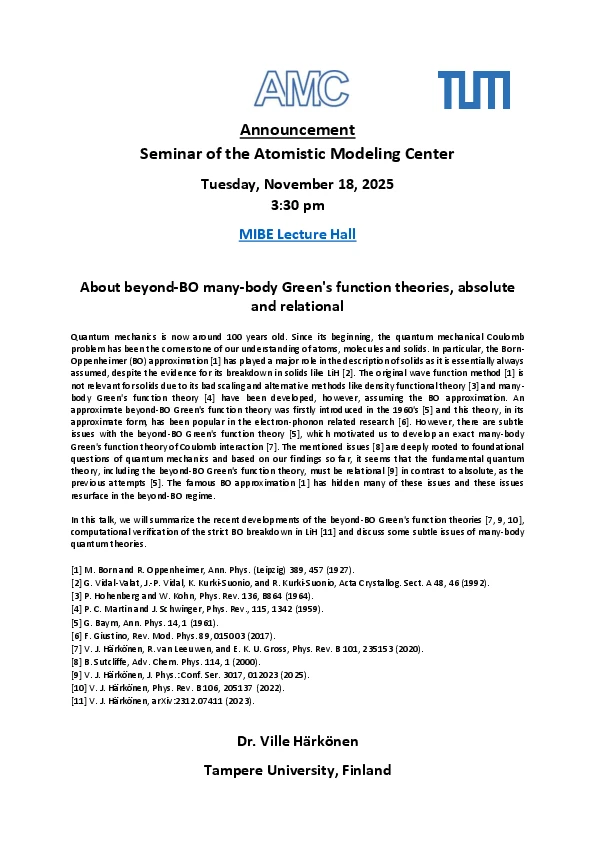The AMC Seminar is back! After the summer break, our Winter Term Seminar Series on Atomistic Modeling-related topics will resume, taking place every Tuesday.
The head of the Many-Body Theory group, Ville Härkönen, focuses on the theoretical and computational study of systems within the area of non-relativistic many-body quantum mechanics. He is a senior research fellow at the Tampere Institute for Advanced Study and works at the Computational Physics Lab at the Faculty of Engineering and Natural Sciences at Tampere University in Finland. His group aims to gain a better understanding of various phenomena, such as superconductivity. They develop theories by using the tools of many-body quantum mechanics and quantum field theory. Part of their research is the computational study of experimentally known solids, where they implement the developed theories.
In his talk “About beyond-BO many-body Green's function theories, absolute and relational”, Härkönen will summarize the recent developments of the beyond-BO Green's function theories and computational verification of the strict BO breakdown in LiH, and will discuss some subtle issues of many-body quantum theories.
Date: Tuesday, November 18, 2025, 3:30 pm
Location: MIBE Lecture Hall
Abstract:
Quantum mechanics is now around 100 years old. Since its beginning, the quantum mechanical Coulomb problem has been the cornerstone of our understanding of atoms, molecules and solids. In particular, the Born-Oppenheimer (BO) approximation [1] has played a major role in the description of solids as it is essentially always assumed, despite the evidence for its breakdown in solids like LiH [2]. The original wave function method [1] is not relevant for solids due to its bad scaling and alternative methods like density functional theory [3] and many-body Green's function theory [4] have been developed, however, assuming the BO approximation. An approximate beyond-BO Green's function theory was firstly introduced in the 1960's [5] and this theory, in its approximate form, has been popular in the electron-phonon related research [6]. However, there are subtle issues with the beyond-BO Green's function theory [5], which motivated us to develop an exact many-body Green's function theory of Coulomb interaction [7]. The mentioned issues [8] are deeply rooted to foundational questions of quantum mechanics and based on our findings so far, it seems that the fundamental quantum theory, including the beyond-BO Green's function theory, must be relational [9] in contrast to absolute, as the previous attempts [5]. The famous BO approximation [1] has hidden many of these issues and these issues resurface in the beyond-BO regime.
In this talk, we will summarize the recent developments of the beyond-BO Green's function theories [7, 9, 10], computational verification of the strict BO breakdown in LiH [11] and discuss some subtle issues of many-body quantum theories.
References:
[1] M. Born and R. Oppenheimer, Ann. Phys. (Leipzig) 389, 457 (1927).
[2] G. Vidal-Valat, J.-P. Vidal, K. Kurki-Suonio, and R. Kurki-Suonio, Acta Crystallog. Sect. A 48, 46 (1992).
[3] P. Hohenberg and W. Kohn, Phys. Rev. 136, B864 (1964).
[4] P. C. Martin and J. Schwinger, Phys. Rev. 115, 1342 (1959).
[5] G. Baym, Ann. Phys. 14, 1 (1961).
[6] F. Giustino, Rev. Mod. Phys. 89, 015003 (2017).
[7] V. J. Härkönen, R. van Leeuwen, and E. K. U. Gross, Phys. Rev. B 101, 235153 (2020).
[8] B. Sutcliffe, Adv. Chem. Phys. 114, 1 (2000).
[9] V. J. Härkönen, J. Phys.: Conf. Ser. 3017, 012023 (2025).
[10] V. J. Härkönen, Phys. Rev. B 106, 205137 (2022).
[11] V. J. Härkönen, arXiv:2312.07411 (2023).
